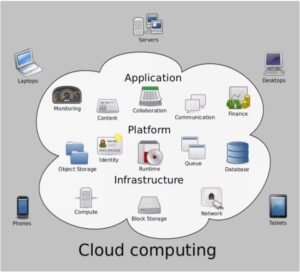Cloud Computing
For those who have heard the term but don’t really know what all the fuss is about read on.
Cloud computing is a relatively new term that is being thrown around quite a lot. The concept dates back to the first computers that were available to industry. So while the term is new, the concept is not new at all.
If you are fortunate enough, or have been fortunate enough to have visited the Computer History Museum in Silicon Valley, the evolution of computing is on full display for all to see. Computers used to fill a very big room, were cumbersome to operate and were very expensive. We really do take our current desktops and what they can do for granted. Visiting something like the Computer History Museum really highlights this fact. I highly recommend a visit if you are in San Francisco and are interested in computing.
Some History
Back in 1970, a claim was made that “the number of transistors in an integrated circuit would double every two years” or in layman’s terms “the processing power of computers will double every two years“. This statement, made back in 1970 has become known as Moore’s Law and arguably remains true today.

Back in the 1970’s, processing power was very poor by today’s standards and more importantly, very expensive. Companies used to buy processing power in CPU cycles and only very large companies could afford to do this.
Just as processing power has increased over time, so has computer storage. Perhaps not doubling every 2 years although if you think back to what was around in your childhood you will get an idea of just how far we have come. The big change came between 2000 and 2015 when the price of a single gigabyte of storage plummeted. The price falling from more than four dollars in 2000 to less than four cents in 2015. Storage, like processing power became very cheap and readily available.
Telecommunications has evolved just as fast as computer processing power and storage. If you are old enough to remember the humble dial up modem used extensively in the 1980s and earlier, 9.6 kilo-bits per second was about as fast as you could go in the 80s. The 1990s bought us 14.4 kilo-bits per second and what was considered lightning fast 56 kilo-bits per second.

In comparison, we now have 100 megabits per second to our home and 1 Gigabit connections to our office.
What a computer and telecommunications can do today was unthinkable not so long ago; what’s coming is just as unthinkable.
Back when processing power, storage and telecommunications were very expensive, those who could afford them would rent or pay for what they needed to get the job done. This is cloud computing and the concept has been around for quite some time.
Where we are today
Cloud computing is around today because processing power, storage and telecommunications are cheap. We have gone full circle.
Today’s cloud computing concept is identical to that of the past, “rent or pay for what you need to get the job done”.
When you buy a File Server today, you have to buy something that has the necessary processing power and storage for today and until the life of the file server is over. You are buying more than you currently need in the hope that you will use all the capacity that you have purchased. While all this is now cheaper than it ever was, the concept of buying more than you need is wasteful. A file server will still cost anywhere between $10,000 and $30,000 depending on the purpose it is designed to serve. The same can be achieved for far less using cloud computing based resources.
Cloud Resources
As previously mentioned, what the personal computer can do today was unthinkable not so long ago. What is available to us today as a cloud computing resource would have been unthinkable back in the 1970s.

The typical things we can buy today as a cloud resource include:
- Software-as-a-Service (SaaS)
Platform-as-a-Service (PaaS)
Infrastructure-as-a-Service (IaaS)
This list will grow over time as new services are developed. There are also quite a few vendors available to choose from that provide cloud computing resources. The main players are Microsoft, Google and Amazon and many more smaller players.
The good, the bad and the ugly
It is important to understand what cloud computing is in order to determine if it is right for your business. I hope this blog has given you that understanding.
What needs to be considered is your particular situation and what you are trying to achieve. Like any commercial decision, will cloud computing provide you with the best outcome for the cost and can you mitigate the risks involved with moving to a cloud based solution. So here are the risks to consider.
Security
Cloud computing requires you to send data to, and store it on, a vendor-managed system. The privacy and security risks associated must be weighed against the benefits as well as the alternatives. Most of the security implications can be mitigated with what is available today. You could argue that the security available on a cloud based platform is greater than what is available with an on-premises solution. To a large degree, this is true or at least it is much cheaper to implement these enhanced security features on a cloud based system versus on-premises systems.
We see organisations preferring on-premises systems and not deploying the enhanced security that a cloud based system can offer because of the cost. Security therefore comes down to what you or your organisation are comfortable with. Every one has a different comfort level and for different reasons. Some of the reasons we hear are quite valid while the majority are because the decision maker is ill informed.
Control
Once you are a customer of a cloud computing vendor, you give up management control over the system. You rely on the provider to deliver the needed reliability and performance levels. Remember, you don’t own any of the cloud computing resources and therefore don’t have effective control over them. You simply use whatever you have purchased.
This can be viewed as a positive or a negative depending on which camp you belong to. The positive is, it’s become someone else problem to wear the capital cost, depreciation, upkeep, and management of the resources. The down side is you do not have control of any of this. As an IT person, not having control is bad. As a business person, control is delegated and not having to worry about capital cost, depreciation, upkeep, and management is great. We see many IT centric people not wanting to move to the cloud and our view is it is not because of security, it is because of control.
Telecommunications
Temporary outages and slower-speed broadband that are a minor nuisance today become a significant problem if you are fully committed to a cloud-based solution. Your telecommunications service and infrastructure needs to be designed to cope with the move to a cloud computing solution. Simply moving everything to the cloud and not understanding that telecommunications is the underling foundation that provides you with the access will provide a very bad experience.
Temporary outages are less of a problem as computers can be “hot spotted” from a mobile phone as a temporary measure. The biggest problem we see is with organisations not considering the impact on their telecommunications services when moving to the cloud.
Wrap up
Cloud computing can be a difficult concept to get your head around and can have significant implications for your business if not implemented properly. It is so easy to purchase services today that we see organisations just going off and grabbing what they need. The vendors deliberately make the purchase an easy decision.
As with any commercial decision that can significantly impact on your business, being well informed and having a plan in place is always going to provide you with the best result.
As always, we are here to help. Feel free to contact us for any advice, assessment or anything else that you may require.


